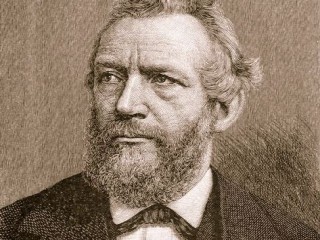
Emil Du Bois-Reymond biography
Date of birth : 1818-11-07
Date of death : 1896-12-26
Birthplace : Berlin, German
Nationality : Germany
Category : Famous Figures
Last modified : 2011-04-12
Credited as : Physiologist, modes of action of nerves and muscles,
The German physiologist Emil Du Bois-Reymond (1818-1896) made important discoveries about the modes of action of nerves and muscles and was the founder of modern electrophysiology.
Emil Du Bois-Reymond was born in Berlin on Nov. 7, 1818. His early education was gained partly at the French College in Berlin and later at the College of Neuchatel. At the age of 18 he entered the faculty of philosophy at the University of Berlin. He once described himself (in 1875) as having "intellectual leanings impelling me in almost equal degree in various directions of natural knowledge." His eclectic tastes were reflected in his early years at the university when he studied philosophy, theology, mathematics, physics, and chemistry. In 1841 he became assistant to Johannes Muller, who suggested that he study some of the electrical properties of muscle and thus guided Du Bois-Reymond into a field of study which was to engross him for the next half century.
Succeeding Muller as professor of physiology in Berlin in 1858, Du Bois-Reymond agitated for a new, well-equipped department. Because of his influence with the German emperor, who much admired him, a new physiological institute was built on the Wilhelmstrasse, and it opened on Nov. 6, 1877. It served as a model for the design of physiological laboratories until the end of the 19th century. The main lecture theater contained the unusual feature of a private box for visiting royalty, which, surprisingly, was occasionally occupied by Du Bois-Reymond's imperial patron.
Du Bois-Reymond's honors and appointments were legion. In 1867 he was appointed perpetual secretary of the Berlin Academy of Sciences. Between 1859 and 1877 he was joint editor of Mullers Archiv, and afterward, until his death, he edited Archiv fur Physiologie. He served as president of both the Physical and the Physiological societies of Germany and was elected a foreign fellow of the Royal Society of London.
Many physiologists during the 19th century were attracted to "vitalism." Muller himself was a protagonist of this philosophy, which held that a vital force, present in living things, could alter physical and chemical laws. It was suggested that the organism functioned as a whole and that experimentation on its separate functions was invalid. Du Bois-Reymond rejected this indeterminate theory. He was a "materialist" and believed in the cogency of scientific analysis of the components of living processes. He was attracted to the materialistic philosophers and wrote memoirs of some of them, including Voltaire and Denis Diderot. His own philosophical views were outlined in two collections of essays, The Limits of Natural Science (1872) and Seven World Riddles (1880). His writings encompassed other nonscientific topics; among them were essays on university organization (1870) and on the relationship between natural history and natural science (1878).
Du Bois-Reymond died at Berlin on Dec. 26, 1896.
Luigi Galvani late in the 18th century discovered that muscle has electrical properties. During the same period Alessandro Volta showed that muscles can be made to contract continuously by rapidly repeated electrical stimulation. Volta was describing tetanic contraction, though this label was introduced much later, in 1838, by Carlo Matteucci. Matteucci determined that a difference of potential exists between a nerve and its damaged muscle. Du Bois-Reymond defined the phenomenon of tetanization and first repeated Matteucci's experiments and then went on to augment them.
Du Bois-Reymond introduced the technique of stimulating nerve and muscle by means of a short-duration (faradic) current from the modified induction coil which he devised and which bears his name. He was the first to demonstrate that muscular contraction is accompanied by chemical changes in the muscle, and he also confirmed. that the cut surface of a muscle exhibits a difference in electrical potential from that of its intact surface. Further, he suggested that muscles and nerves contain electromotive molecules. In 1843 he demonstrated that ions are formed within a nerve when it is stimulated by a current from a nonpolarizable electrode; this phenomenon he called electrotonus. He discovered that there is a negative change in potential from the resting state when nerves or muscles are stimulated (1843-1848). Using his induction coil, he formulated his "law of stimulation," which postulated that nerve and muscle are not excited by a constant current, no matter what its strength, but that they are very responsive to sudden changes in current intensity.
The summary of Du Bois-Reymond's hypotheses was a postulation that all the electrical phenomena accompanying neural and muscular activity depend on electromotive molecules, arranged end to end, along cylinders of tissue. He believed that electrophysiological stimulation was simply a form of electrolysis.
Du Bois-Reymond rarely published discoveries in separate papers. The bulk of his work appeared collectively in his most famous book, Untersuchungen Uber Thierische Elektricitat (Researches on Animal Electricity). The first volume appeared in 1848, the first part of the second volume in the following year. Eccentrically, the latter book ends in the middle of a sentence, which remained incomplete until the rest of the second volume was published 35 years later (1884).
Most of Du Bois-Reymond's observations were correct and have since been confirmed, but his theoretical inferences often proved to be wrong. He was, however, a pioneer in the study of neuromuscular physiology and its electrical correlates and indicated the method and the direction of future experiments. His ideas, though wrong in detail, contain in embryo form part of the modern concept of neurophysiology that nerve and muscle conduction is mediated by the passage of an electrical wave whose generation depends on a flux of ions across the tissue membrane.
















